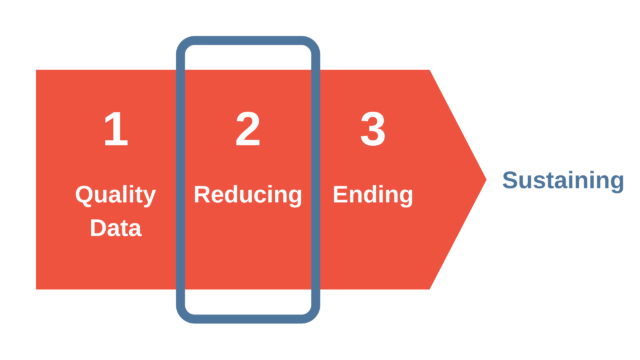Our Anchor Communities have been making amazing progress to end youth and young adult homelessness, with one community reaching quality real-time data, and three out of four communities have completed the By-Name List Scorecard. It feels like the perfect time to highlight what’s next for A Way Home Washington and the Anchor Community Initiative.
As a refresher, the Anchor Community Initiative is based on the Built for Zero model, which has four phases. The first phase requires communities to achieve quality, real-time data. This has already been achieved by Pierce County, while Walla Walla and Yakima County are only a couple months away. The second phase is reducing. At this point, communities begin to implement improvement projects and use quality real-time data to evaluate the success of these projects.
So, what does reducing mean fo r to the Anchor Community Initiative? At a high-level, it means lowering the number of young people experiencing homelessness across the entire system. To start this process, our Data and Evaluation Director, Liz, has created different focus areas, or reducing process measures. Communities set goals around any of the following focus areas to start seeing reductions in their homeless numbers:
r to the Anchor Community Initiative? At a high-level, it means lowering the number of young people experiencing homelessness across the entire system. To start this process, our Data and Evaluation Director, Liz, has created different focus areas, or reducing process measures. Communities set goals around any of the following focus areas to start seeing reductions in their homeless numbers:
1. Lowering the number of unsheltered young people
2. Increasing the number of housing placements
3. Lowering returns from housing into homelessness
4. Lowering the average length of time young people experience homelessness
Pierce County is the first community to set a goal around one of these measures: They will focus on increasing housing placements by 30% by August 2020. As communities begin reporting race/ethnicity data and sexual orientation, gender expression and identity (SOGIE) data, they will be able to further refine their goals by adding an equity component. For example, if a community’s data shows that Black young people are housed at a lower rate than young people of other ethnicities, the community can set a goal around increasing housing placements for this population.
Communities will have access to a new tool to boost their reduction efforts: The Centralized Diversion Fund. Starting in July 2020, these flexible funds will be accessible to young people through local service providers to support them with costs like short-term rental assistance, move-in costs, and more. This will help young people stay housed and reduce the number of young people coming into the homeless system.
Youth and young adult engagement is a staple of the Anchor Community Initiative. Communities have laid the groundwork, and now they will continue to build towards the Gold Standard for youth and young adult engagement. Young people will be treated as experts and leaders in the work. This means that young people will be part of hiring, strategy development, and project implementation during this phase of the work, including choosing at least two reduction improvement projects.
Throughout all this work, we will capture best practices and successes in each community to share with other Anchor Communities and aid them in their processes. After reducing, the third phase of the work is ending youth and young adult homelessness. This means communities will create a Yes to Yes system where they have the capacity to support every young person who needs help and achieve equitable outcomes for young people of color and LGBTQ+ young people. We’re working hard to help communities end youth and young adult homelessness by the end of 2022 and sustain their achievement for generations to come!

Leave a Reply